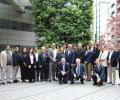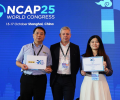FIA World Council for Automobile Mobility and Tourism meets in Montevideo
After a week of key meetings in the Uruguayan capital, the FIA’s top mobility decision-makers convened for a final time to deliberate the major topics in the FIA Mobility landscape.

Jean Todt, FIA President, welcomed FIA World Council for Automobile Mobility and Tourism members to the final meeting of a productive Mobility Conference week. He thanked them for their contribution and insights before handing the floor to Thierry Willemarck, FIA Deputy President for Automobile Mobility and Tourism, who chaired this World Council.
One of the key aspects of the meeting was the fact that the World Council is increasing its focus on urban and sustainable mobility alongside its wide-ranging work on road safety.
It is doing this in a variety of ways, many of which were discussed during the meeting. Firstly, Felipe Calderón, President of the new FIA Environment and Sustainability Commission, gave a presentation to the World Council on the upcoming work of the Commission.
“The FIA has a new role,” said Mr Calderón. “We must provide guidance for the customers and Club members in light of increased regulation and shifting public opinion, thus strengthening the FIA’s leadership in global sustainability.”
Following this, Jorge Tomasi Crisci, ACU President and FIA Region IV President, updated the World Council on activities taking place under his Presidency in 2018, again reflecting the increased importance of urban and sustainable mobility in areas of advocacy and public policy, Club development, and services and communications.
Andrew McKellar, FIA Secretary-General for Automobile Mobility and Tourism, described the current situation of the FIA Innovation Fund (FIF), outlining the three projects which have been granted funding to date – the FIA European Young Women’s Programme, the Youth Olympic Games projects and the FIA Helmet Rating Programme. The third project was of particular interest to World Council members, as it can be clearly and simply translated into the mobility sphere, encouraging the identification of good quality affordable helmets in low-income areas.
Mr McKellar was keen to emphasise the importance of coordination between Clubs in their Regions when submitting applications for funding, saying, “We must harness the unique capacities of the Regions to streamline and coordinate this resource.”
It was also suggested that the FIF could potentially be used to support projects relating to sustainable urban mobility, and that any proposals should have relevancy for Members at their core. “A critical issue as we go forward is how to ensure we cultivate the best ideas that come from the FIA network and ensure that the projects supported by this fund remain relevant for Members,” added Mr McKellar.
Turning specifically to the topic of road safety, the World Council was updated on the status of the FIA’s Global Road Safety Campaign ‘#3500LIVES’, and the work of the FIA High Level Panel for Road Safety (HLP).
This World Council was also an opportunity to introduce the FIA Road Safety Awards initiative. The aim would be to commend the efforts of individuals and organisations contributing to the reduction in lives lost on the roads and making an impact on global road safety. If approved, the initiative would begin from 2019 and be held annually at the FIA Mobility Conference.
FIA President Todt also paid tribute to former HLP member Sergio Marchionne, who sadly passed away earlier this week.
On FIA related Travel and Tourism Services, the WCAMT approved the proposed review of “OTA Phase 2”; the proposed solution as a non-AIT/FIA member for a new CPD distributor and guarantor in Jordan as well as the proposed IDP protection programme as an “OPT in / OPT out” model.
Finally, the WCAMT approved the recommendation on the regional division for Region III and Region IV, and subsequent amendments to the FIA statutes as recommended in the dossier by the FIA Administration.

 Facebook
Facebook Twitter
Twitter






